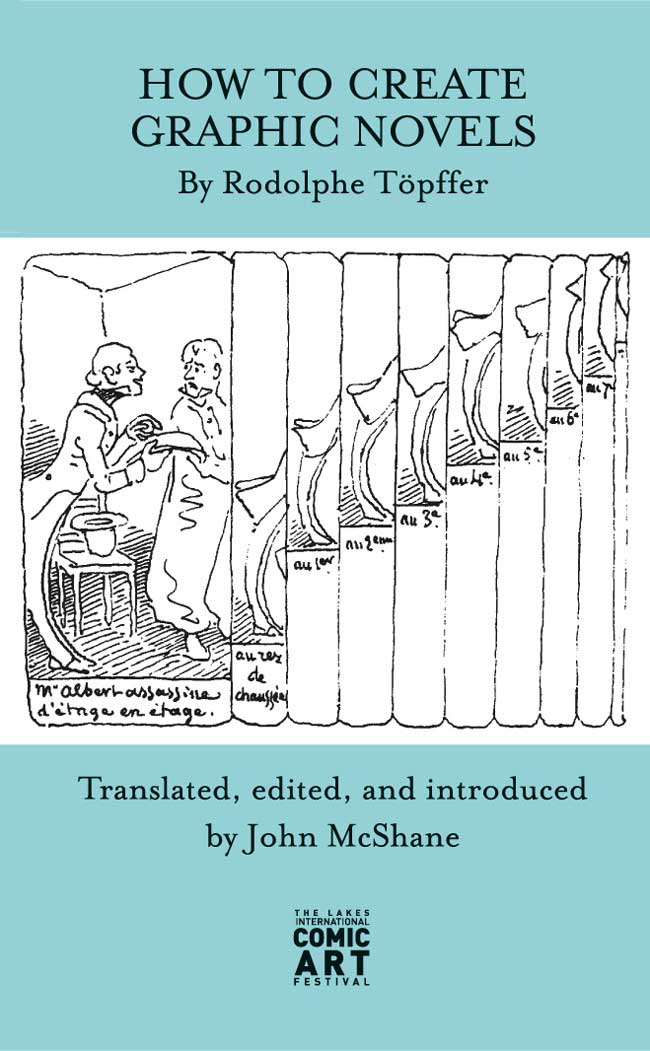
The Lakes International Comic Art Festival has announced the publication of a special edition of How to Create Graphic Novels by Rodolphe Töpffer.
First published in 1845, it was the first ever book on creating graphic novels, which has been translated, edited, and introduced by John McShane and designed by Festival patron Sean Phillips.
Along with the recently-announced The Spirit of Eisner newspaper, this book is another indicator of the Festival's wider commitment to the comics medium, which has also included the publication of new work such as Dave McKean's Black Dog: The Dreams of Paul Nash, Coelifer Atlas and Carrot to the Stars, an English language edition of La carotte aux étoiles by Riff Reb’s, and 24 By 7, the Eisner Award-nominated collection of short strips edited by Dan Berry featuring strips created during the Festival's 24 Hour Comic Marathon in 2014.
Born in Geneva in 1799, Töpffer was a schoolmaster, university professor, polemical journalist, art critic, landscape draughtsman and writer of fiction, travel tales, and social criticism. Within two years of the first appearance of the world’s first regularly published comics magazine, The Glasgow Looking Glass (11th June 1825), Rodolphe Töpffer single-handedly started creating what became the world’s first graphic novels.
At first he resisted publishing what he called his "little follies". When he did, they became instantly popular, plagiarised, and imitated throughout Europe and the United States.
In 1845, he wrote "How to Create Graphic Novels", the world’s first book about this new art of the graphic novel.
This new edition has been endorsed by Benoît Peeters, the UK’s only Professor of Graphic Fiction and Comic Art (at Lancaster University) and comics artist and illustrator Dan Berry, Programme Leader for the BA/MDes Illustration, Graphic Novels and Children’s Publishing degree courses at the School of Creative Arts, Wrexham Glyndwr University, who will both be guests at this year's Festival in October.
"Many people who read Will Eisner's A Contract with God in 1987, or Art Spiegelman's Maus in 1980-9, or Alan Moore and Dave Gibbons' Watchmen in 1986-87 probably felt that they were witnessing the first examples of a new form of literature," notes John McShane. "But the truth is that these books were part of a rebirth of the form, a renaissance indeed, that Rodolphe Töpffer created in 1827 – all by himself."
"So, what is this 'little book' which you now hold in your hands all about?
"It is Töpffer’s demonstration of the advantages of the graphic form over prose novels – and how to go about creating your own," John explains. "Töpffer’s theories are still influential to this day, and still worth studying."
“This is where the history of comics as an art form really begins!” enthuses Dave Gibbons, who was Britain's first Comics Laureate, and acted as an ambassador for comic books and their potential to improve literacy. Along with his many other projects, Dave has been busy working on a special comics-related item for this year's Festival.
• How to Create Graphic Novels by Rodolphe Töpffer will be on sale at this year's Lakes International Comic Art Festival but can also be ordered online from Page 45, the Nottingham-based comic shop that has been a longtime supporter of LICAF
• Buy your tickets for the fifth Lakes International Comic Art Festival here
Web Links
Rodolphe Töpffer (1799-1846) lived for most of his life in Geneva, where he taught at the boarding school which he founded. He was a prolific author and latterly took part in political journalism at a turbulent time in his city’s history. But in the midst of all this activity, he created his greatest legacy, the Graphic Novel (histoire en estampes). Today, there is a bust of him in the centre of Geneva, a fitting tribute to one of their most famous sons.
Those interested in learning more about Rodolphe Töpffer are directed to David Kunzle’s Father of the Comic Strip
John McShane who has translatedHow to Create Graphic Novels is the co-author of the best-selling Robert Burns in Edinburgh. His essay on The Glasgow Looking-Glass in The Drouth magazine is the most cited and requested in the magazine’s history. He has also written several short screenplays, stories and comics. He has been a publisher, with Trident Comics and Fat Man Press, and presents many panels at conventions and festivals with stars from comics and films.


